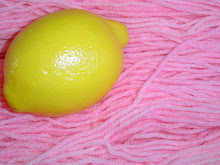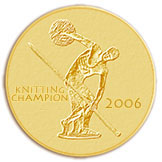Generic Sock - Part 3

Gussets. Gussets are not my favorite part of a sock, but they are important for the fit and honestly, I always feel like once I complete the gusset, I'm on the home stretch. Here's how I do them.
After I've completed my Heel Turn, I divide those stitches on two needles again. The working yarn is at the left end of the heel turn, so with that needle, I begin picking up stitches along the edge of my heel flap. (If you've never knit a sock and have no idea what I'm talking about here, don't worry, go knit a sock and come back after you're done with the Heel Fap and Heel Turn - some things are easier with yarn and needles in your hands.) Because I've slipped a stitch at the first of every row on the Heel Flap, I have a nice line of slipped stitches on each side of the flap, to pick up.
Let me digress here and say that by picking up stitches along the heel flap, I'm not picking up stitches that I've already made. I am lifting a stitch I already made and pulling a loop of the working yarn under it with my needle. That loop of working yarn is the stitch that I've picked up.
OK, back to the picking up of stitches. You want to pick up one stitch for each slipped edge stitch on your heel flap (there will be half the number of slipped edge stitches as there are rows in your heel flap - my example has a 32 row heel flap, so I have 16 edge stitches). Then, I pick up one or two extra at the little V joint where the heel flap joins the leg of the sock. This makes sure I don't have a gap or hole there - that's important because that is a stress point in the sock. Most sock patterns will tell you how many stitches you should pick up along the heel flap but I've always pretty much ignored them. You should pick up as many as you need to to make the gusset attach to the heel flap without holes. Sometimes that's more stitches than the pattern recommends, it might be less. Do what you need to and don't worry too much if you have the exact same number of stitches as the pattern does.
After you've picked up stitches along the first side of the gusset, that needle will have half of the heel turn stitches and your newly picked up stitches. I think of this needle as Needle 4, the last needle of the round. You'll want to knit across Needles 1 and 2 in whatever pattern you were working. Then, with your empty needle, pick up and knit stitches along the second side of the heel flap, making sure to get a few extra at the joint where Needle 2 and the heel flap come together. Try to get the same number of stitches as you did on the first side, but if you need more to make sure there are no holes, that's fine. I've never had anyone wrestle me to the ground and count the number of stitches on the gussets of my socks. After picking up the stitches on the second side of the heel flap, with the same needle, knit the second half of the heel turn stitches. You now have to knit the stitches on Needle 4 again to get all the way around the round. I like to knit through the back loops of the 2 or 3 extra stitches that I picked up because it will tighten them up a bit. You've now knit the first round of your gusset. I like to work a second round without any decreases (I will also knit through the backs of the first few stitches on Needle 3 on this round) because it gives me a little bit of wiggle room to get away from the round of picking up before I start decreases. Also, I like to work my decreases on odd numbered rounds - staying consistent with this means I don't have to think about it. OK, so round 3 of the gusset looks like this: Needles 1 and 2, work as established, Needle 3: K1, SSK, knit to end of needle. Needle 4: knit to last 3 stitches, K2tog, K1. The following round I will work even, with no decreases. I repeat these two rounds, decreasing every other round until I have decreased back to my original stitch count or whatever stitch count I will use for my foot.
On the first day, someone made a comment asking about negative ease, so I'll address it now. I like my socks slightly loose on the leg, but I like them to fit snugly around my foot. In order to get this, I have to take ease (the difference between a garment's measurements and the body's measurements) into account. In stockinette stitch, I like to have negative ease on the foot part of the sock so that the sock doesn't get bunched up in my shoes. Negative ease means that the garment is smaller than the body part it goes on. Because the ball of my foot is 8 inches around, I will make the foot of the socks smaller than 8 inches around (usually by about 10% or so). Since 90% of 8 inches is 7.2 inches and I'm getting 8 stitches per inch on my gauge, I need to continue my gusset decreases until I have 57.6 stitches. Since 57.6 stitches is impossible and I need a number that can be knit and I like a number divisible by 4, I can either decrease to 60 stitches or 56 stitches. In this case I decided on 60 stitches - I can't really tell you why right now. Perhaps with more caffeine and later in the day the reason will become clear to me, but at the moment, I'm just not sure. Once I've decreased my gusset stitches until I am down to 60 total stitches, I can redistribute the stitches evenly on the needles and continue knitting for the foot. A few things I want to mention about negative ease - certain stitch patterns are less elastic so you don't need to have negative ease to get a good fit. I also never use negative ease on kid's socks - they grow too fast. Finally, people with certain health problems don't need tight fitting socks so you want to be careful when knitting socks for them. I'll discuss different stitch options after we've finished the sock. Tomorrow - Toes!










3 Comments:
Thank you so much for doing this! You have finally made me realize that I can do whatever I want when I'm making socks. I no longer have to worry about the Knit Nazis bursting into my living room and saying "Pattern, pleeze"! I'm free! I'm Free!
OK - if the slipped stitches you are going to pick up and knit thru look like Vs - do you pick up and knit thru both 'legs' of the V, only the one on the outside edge, or only the one on the inside edge?
When I pick up stitches, I lift the entire stitch (both legs) and bring the working yarn under to make a stitch. Does this help Diane?
Post a Comment
<< Home